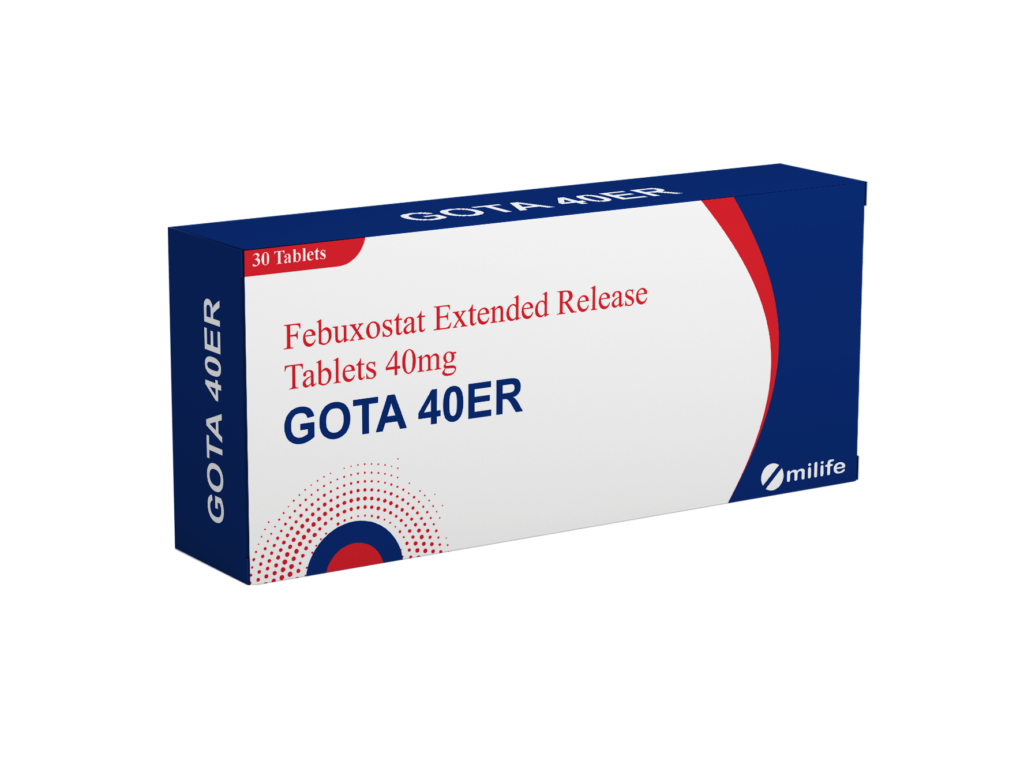
Febuxostat 40 mg Extended Release Tablets use for Treatment of chronic hyperuricaemia in conditions where urate deposition has already occurred (including a history, or presence of, tophus and/or gouty arthritis). Febuxostat Tablets is indicated in adults.
Dosage
Gout: The recommended oral dose of Febuxostat is 80 mg once or twice daily without regard to food. If serum uric acid is > 6 mg/dL (357 μmol/L) after 2-4 weeks, Febuxostat 120 mg daily may be considered. Febuxostat Tablets works sufficiently quickly to allow retesting of the serum uric acid after 2 weeks. The therapeutic target is to decrease and maintain serum uric acid below 6 mg/dL (357 μmol/L). Gout flare prophylaxis of at least 6 months is recommended.
Elderly: No dose adjustment is required in the elderly
Renal impairment: The efficacy and safety have not been fully evaluated in patients with severe renal impairment (creatinine clearance < 30 mL/min). No dose adjustment is necessary in patients with mild or moderate renal impairment.
Hepatic impairment: The efficacy and safety of febuxostat have not been studied in patients with severe hepatic impairment (Child-Pugh Class C). The recommended dose in patients with mild hepatic impairment is 80 mg. Limited information is available in patients with moderate hepatic impairment.
Paediatric population: The safety and efficacy of Febuxostat Tablets in children aged below the age of 18 years have not been established. No data are available.
Directions for Use
For oral use only. Febuxostat ER tablets should be taken by mouth and can be taken with or without food.
The most commonly reported adverse reactions in clinical trials (4,072 subjects treated at least with a dose from 10 mg to 300 mg) and post-marketing experience in gout patients are gout flares, liver function abnormalities, diarrhoea, nausea, headache, rash and oedema. These adverse reactions were mostly mild or moderate in severity. Rare serious hypersensitivity reactions to febuxostat, some of which were associated to systemic symptoms, have occurred in the post-marketing experience.
Common (≥ 1/100 to < 1/10), uncommon (≥ 1/1,000 to < 1/100) and rare (≥ 1/10,000 to < 1/1,000) adverse reactions occurring in patients treated with febuxostat are listed below.
Blood and lymphatic disorders
Rare: Pancytopenia, thrombocytopenia, agranulocytosis*
Immune system disorders
Rare: Anaphylactic reaction*, drug hypersensitivity*
Endocrine disorders
Uncommon: Blood thyroid stimulating hormone increased
Eye disorders
Rare: Blurred vision
Cardio-vascular disorders
Treatment of chronic hyperuricaemia
Treatment with febuxostat in patients with ischaemic heart disease or congestive heart failure is not recommended.
Medicinal product allergy / hypersensitivity
Rare serious allergic/hypersensitivity reactions, including life-threatening Stevens-Johnson Syndrome, Toxic epidermal necrolysis and acute anaphylactic reaction/shock, have been reported.
Patients should be advised of the signs and symptoms and monitored closely for symptoms of allergic/hypersensitivity reactions.
Febuxostat treatment should be immediately stopped if serious allergic/hypersensitivity reactions, including Stevens-Johnson Syndrome, occur since early withdrawal is associated with a better prognosis and febuxostat must not be re-started in this patient at any time.
Acute gouty attacks (gout flare)
Febuxostat treatment should not be started until an acute attack of gout has completely subsided. Gout flares may occur during initiation of treatment due to changing serum uric acid levels resulting in mobilization of urate from tissue deposits.
At treatment initiation with febuxostat flare prophylaxis for at least 6 months with an NSAID or colchicine is recommended.
If a gout flare occurs during febuxostat treatment, it should not be discontinued. The gout flare should be managed concurrently as appropriate for the individual patient. Continuous treatment with febuxostat decreases frequency and intensity of gout flares.
Store below 30°C. Protect from light and moisture.
Keep out of reach of children.
3 x 10 Alu/PVC blister pack
Febuxostat Extended Release Tablets (GOTA 40ER) is available in an Alu/PVC blister of 10 tablets. Such 03 blisters in a unit carton with package insert.
Contact us directly to receive full information on the product, the formulation, the science behind it, stability data, and more. Our Business Development Manager is a click away.
Conical Pharmaceuticals is a professionally managed and dynamic organization with decades of experience in the pharmaceutical field. With a desire of providing opportunities for a better life, we work very hard to bring quality drugs to our customers. We have instilled a level of trust and confidence amongst our clients by supplying the best quality products.